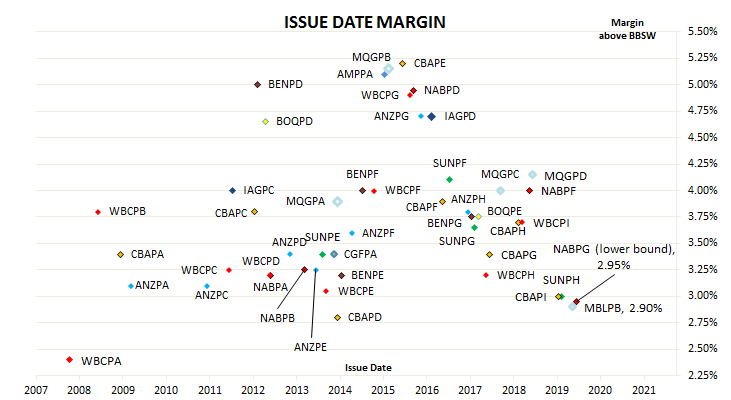Editor’s note: This issue did not go ahead. It was “pulled” by NAB on 12 March 2020.
In recent years, when an existing Australian hybrid approaches its first call date (or first optional exchange date), speculation turns to the likelihood of a replacement security. Just last week, Macquarie Bank announced a new hybrid security to effectively replace its existing Macquarie Bank Capital Notes. Now it is National Australia Bank’s (NAB) turn as its first series of capital notes is fast approaching its March 2020 call date.
National Australia Bank plans to raise $750 million via an issue of Capital Notes 4 (ASX code: NABPG) securities, with the ability to raise more or less than this amount. The new securities will be perpetual, convertible, subordinated, unsecured notes and the proceeds will be used “for general corporate purposes”. General corporate purposes could be reasonably interpreted as the partial funding of the resale/redemption of NAB’s existing Capital Notes (ASX code: NABPC).
However, there are just over $1.3 billion worth of NABPCs on issue (in terms of their face value) and NAB intends to “resell” them in late March, effectively redeeming them. One could expect NAB to issue more than $750 million of the new hybrids given the Australian Prudential Regulation Authority’s (APRA) preference for banks operating in Australia to hold higher levels of loss-absorbing capital.
The new notes have some features in common with equities and some features in common with debt securities. Distributions are at the discretion of directors but they are calculated according to a set formula with reference to the $100 face value of the securities. The notes will qualify as Additional Tier 1 (AT1) capital under the Basel III bank regulatory framework, which means they have the now-standard “event” clauses which may lead to early conversion into ordinary shares or a write-off of the capital notes should APRA require it. In the event National Australia Bank were wound up (and APRA had not already forced a write-off), its hybrids would rank above ordinary shares but below ordinary debt securities and other liabilities.
The new capital notes have an indicative distribution rate equivalent to 3-month BBSW plus a margin of 295bps to 315bps. The final margin will be determined by a “book build” on 24 February 2020. A book build is a tender process managed by investment banks on behalf of the issuer in which investment institutions each place bids for a set volume at a price/yield. (This is the same way as the AOFM holds tenders to sell government bonds each week). If history is any guide, then the margin is likely to be set at the lower end which, in this case, is 2.95% or 5bps more than Macquarie Bank’s latest hybrid security.
Distributions will be non-cumulative, at the discretion of directors and paid quarterly in arrears. However, should a distribution not be paid, NAB cannot declare or pay a dividend on its ordinary shares or even buy-back or reduce its ordinary share capital.
At the prevailing level of interest rates and assuming the margin is set at the lower end of the indicative range, the new notes will initially pay around 3.85% (annualised) inclusive of franking credits. *As interest rates change, specifically the bank bill swap rate, quarterly payments will also change.
The first call date is on 17 September 2027. This is the first date at which NAB can exchange all or some of the securities in the absence of a “Non-Viability Trigger Event” or one of the other types of “event”. Exchange, in the context of listed hybrids, may mean redeem, resell to a third party or convert into ordinary shares. The scheduled mandatory exchange date is 17 September 2029.
The chart above shows the history of issue margins of hybrid securities over the last decade, including the GFC period in 2008/2009. The new capital notes are shown at the lower end of the indicative margin (295bps). Issue margins are set close to the margins of comparable hybrids already trading on the ASX. Readers will see NAB’s likely issue margin on its latest hybrid is very much at the lower section of the band which existed from 2009 to mid-2015 (although BENPD and BOQPD are obvious exceptions).

